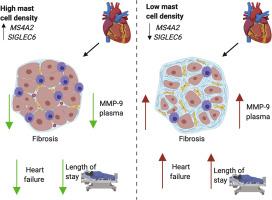Journal of Molecular and Cellular Cardiology ( IF 4.9 ) Pub Date : 2020-09-12 , DOI: 10.1016/j.yjmcc.2020.09.001 Stephanie A Legere 1 , Ian D Haidl 2 , Mathieu C Castonguay 3 , Keith R Brunt 4 , Jean-François Légaré 5 , Jean S Marshall 1 ,

|
Fibrotic remodelling of the atria is poorly understood and can be regulated by myocardial immune cell populations after injury. Mast cells are resident immune sentinel cells present in the heart that respond to tissue damage and have been linked to fibrosis in other settings. The role of cardiac mast cells in fibrotic remodelling in response to human myocardial injury is controversial. In this study, we sought to determine the association between mast cells, atrial fibrosis, and outcomes in a heterogeneous population of cardiac surgical patients, including a substantial proportion of coronary artery bypass grafting patients. Atrial appendage from patients was assessed for collagen and mast cell density by histology and by droplet digital polymerase chain reaction (ddPCR) for mast cell associated transcripts. Clinical variables and outcomes were also followed. Mast cells were detected in human atrial tissue at varying densities. Histological and ddPCR assessment of mast cells in atrial tissue were closely correlated. Patients with high mast cell density had less fibrosis and lower severity of heart failure classification or incidence mortality than patients with low mast cell content. Analysis of a homogeneous population of coronary artery bypass graft patients yielded similar observations. Therefore, evidence from this study suggests that increased atrial mast cell populations are associated with decreased clinical cardiac fibrotic remodelling and improved outcomes, in cardiac surgery patients.
中文翻译:

肥大细胞密度增加与人心房组织纤维化减少有关。
心房的纤维化重塑知之甚少,并且可以通过受伤后的心肌免疫细胞群进行调节。肥大细胞是存在于心脏中的常驻免疫哨兵细胞,对组织损伤做出反应,并在其他情况下与纤维化有关。心脏肥大细胞在响应人类心肌损伤的纤维化重塑中的作用是有争议的。在这项研究中,我们试图确定肥大细胞、心房纤维化和心脏手术患者异质人群的结果之间的关联,包括相当大比例的冠状动脉旁路移植术患者。通过组织学和通过液滴数字聚合酶链反应 (ddPCR) 评估肥大细胞相关转录物的胶原蛋白和肥大细胞密度,评估患者心耳的胶原蛋白和肥大细胞密度。还跟踪了临床变量和结果。在不同密度的人心房组织中检测到肥大细胞。心房组织中肥大细胞的组织学和 ddPCR 评估密切相关。与肥大细胞含量低的患者相比,肥大细胞密度高的患者纤维化程度较低,心力衰竭的严重程度或死亡率较低。对冠状动脉旁路移植术患者的同质人群的分析产生了类似的观察结果。因此,这项研究的证据表明,在心脏手术患者中,增加的心房肥大细胞群与减少临床心脏纤维化重构和改善结果有关。心房组织中肥大细胞的组织学和 ddPCR 评估密切相关。与肥大细胞含量低的患者相比,肥大细胞密度高的患者纤维化程度较低,心力衰竭的严重程度或死亡率较低。对冠状动脉旁路移植术患者的同质人群的分析产生了类似的观察结果。因此,这项研究的证据表明,在心脏手术患者中,增加的心房肥大细胞群与减少临床心脏纤维化重构和改善结果有关。心房组织中肥大细胞的组织学和 ddPCR 评估密切相关。与肥大细胞含量低的患者相比,肥大细胞密度高的患者纤维化程度较低,心力衰竭的严重程度或死亡率较低。对冠状动脉旁路移植术患者的同质人群的分析产生了类似的观察结果。因此,这项研究的证据表明,心脏手术患者的心房肥大细胞群增加与临床心脏纤维化重塑减少和预后改善有关。对冠状动脉旁路移植术患者的同质人群的分析产生了类似的观察结果。因此,这项研究的证据表明,在心脏手术患者中,增加的心房肥大细胞群与减少临床心脏纤维化重构和改善结果有关。对冠状动脉旁路移植术患者的同质人群的分析产生了类似的观察结果。因此,这项研究的证据表明,在心脏手术患者中,增加的心房肥大细胞群与减少临床心脏纤维化重构和改善结果有关。











































 京公网安备 11010802027423号
京公网安备 11010802027423号